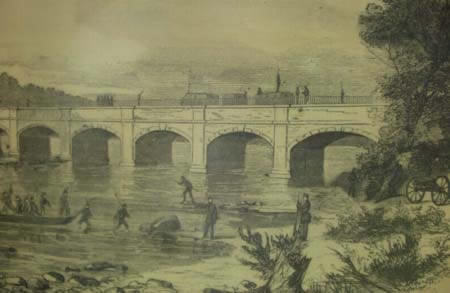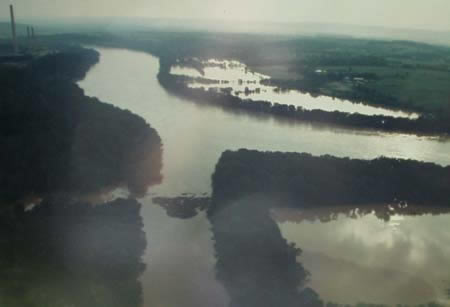Notes on Monocacy Aqueduct, Clapham's Ferry, &tc.
Reference in C&O Canal Companion: Mile 42.2
|
Harper's Weekly depiction of the Aqueduct during the Civil War.
|
To be addedMile 42.2 : The aqueduct
was designed by Benjamin Wright, sometimes referred to as "the
father of American civil engineering." Initially, the canal company
planned to use stone from "Mrs. Nelson?s quarry" at the base
of Sugarloaf Mountain. According to the latest NPS research (in connection
with the rehabilitation project), the stone proved to be too soft for
its purpose, and Wright directed that the first three partially constructed
piers be torn down. Instead, "white stone" from Joseph B.
Johnson?s quarry, also referred to as granite, was ordered to be used
for all structural purposes. Construction was beset with difficulties,
as Wright left to work on other canal projects and the company passed
the project through a succession of contractors. The aqueduct was finally
completed under the direction of Alfred Crueger on April 1, 1933 and
that section was watered in the last weeks of October 1933. (based
on research *** On Lee's orders a second attempt to demolish the aqueduct was made by Brigadier General John Walker on the night of September 9. Lee's plan, as he described it to General Walker, was to isolate Washington, Baltimore, and Philadelphia from reinforcements from the west, starting with the canal and the B&O Railroad, and moving on to the destroy the Pennsylvania Railroad bridge over the Susquehanna. But Walker found the aqueduct so "admirably constructed" that there was no seam or crevice to insert a crowbar, and the drills that he had to make holes for the blasting powder were too dull and the rock too hard. As Union forces approached ... *** In 1756, Josias Clapham obtained a license from the Virginia Assembly to run a ferry from his land in Virginia over to the mouth of the "Monocochisey" in Maryland. He was in direct competition with Noland's Ferry upstream, but the road to his crossing was less convenient. Perhaps for this reason, the Assembly set his rate at four pence, substantially lower than the sixpence charged by Noland. Clapham's rivalry with Noland appears to have petered out by the Revolutionary War, along with his ferry business. In 1816, a ferry was authorized here in the name of Hawlings, and by the time of the Civil War, the crossing-place at the Monocacy was known as Haulings or Hawlings Ford. *** George Washington visited the mouth of the Monocacy, probably on October 17, 1790, after meeting with Georgetown property owners to discuss possible sites for the federal city. Francis Deakins owned land at the mouth of the Monocacy, and several weeks later sent Washington a rough plat of the area, half-heartedly adding, "Having no assistance in laying down the plats--much Other business on hand and a faint expectation of its possessing Superiour advantages to any other place, I hope will in Some degree apologize for the Roughness of it." Deakins probably realized that prospects of placing the federal city above the falls of the Potomac were relatively unlikely (also see discussion of Washington's visit to Williamport, mile 99.6). However, there were no hard feelings -- Deakins' brother, William was a major property owner in the vicinity of Georgetown, and stood to gain from the placement of the capital at that location. When William Deakins died, Francis inherited his concerns (and sizable debts), and ended up head of the committee that welcomed President John Adams to the new capital in June of 1800.
|
Additional NotesMonocacy Aqueduct Restoration Project: As noted in the C&O Canal Companion, the Aqueduct has suffered a great deal of flood damage over the years, and is held together by unsightly steel braces. On Saturday, September 7, the National Park Service held a kickoff ceremony for the restoration of the Monocacy Aqueduct. The C&O Canal Association, the National Trust for Historic Preservation, and the American Society of Civil Engineers were given much of the credit for their efforts to get funding for the project. The C&O Canal Association raised more than $150,000 in contributions towards the restoration effort and the National Trust for Historic Preservation listed the Monocacy Aqueduct as one of 11 most endangered historic places in the United States, which led to a visit and show of support by First Lady Hilary Clinton in June 1998. Maryland Senators Sarbanes and Mikulski and Representatives Morella and Bartlett were also credited for their work in getting a $6 million federal appropriation for the project. The contractor on the project is Corman Construction, Inc., of Annapolis Junction, Maryland.
Aerial
view of the juncture of the Monocacy with the Potomac
|
DocumentsGeneral Walker's account of the attempt to destroy the Aqueduct:
|
|
Sources:
|


